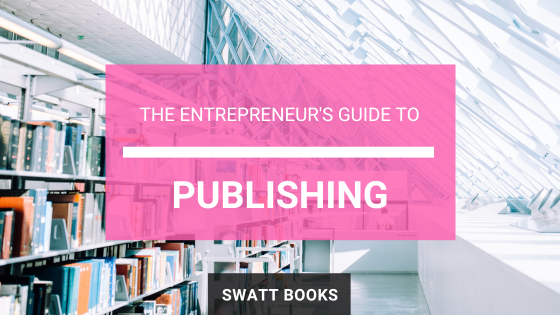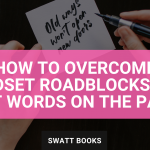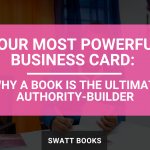As a business owner, you wouldn’t want to give away a controlling interest in your most important IP, would you? Then why would you consider doing exactly that when publishing your book?? If you are thinking about publishing your business book through a traditional publisher, or even a hybrid publisher, that is precisely what you are doing.
Did you know that, according to research conducted by the Alliance of Independent Authors[1], self-published books now account for 30-34% of all e-book sales across the largest English-language markets? This surge in self-publishing isn’t just a trend; it’s an indication of the growing acceptance of a publishing method that empowers authors to maintain control and ownership of their work.
Limitations of traditional & hybrid publishing models
With a traditional publisher, the book deal that you sign with them signs over the rights to your book and its contents to the publisher for them to publish as part of their catalogue. This gives them control over the creative, pricing and distribution, and even the content and tone of voice of your manuscript. Some publishers may invite authors to provide input into these aspects, but the final decision is down to the publisher and not you. To make matters worse for business authors, the small print of many non-fiction book contracts limits what the author can do with that content once it has been published. So you may find yourself needing to ask permission to repurpose your content into an online course or coaching program for example, and no business owner wants to be put in that position.
Hybrid publishers (who tend to be small publishing houses that offer authors a pay-to-publish option of getting their books published) may not be quite as strict in the amount of control they exert over your book and work in a much more collaborative process, but there are still issues once the book has been published. Many hybrid publishers will retain the publication processes of traditional publishers and use their publishing imprints, ISBNs and distribution platforms. This again limits your ability to control what happens to your book in a retail environment. The publisher still retains control of setting the pricing, availability and distribution of your book; and making any changes to your book requires you to go through them unless you want to start from scratch. Not great for a business that needs to remain agile and react to changes in the market.
Self-publishing is not what it used to be
Self-publishing has come a long way in the past two decades, and many highly successful authors, entrepreneurs, and business magnates recognise its’ power to give you the author ultimate control over everything to do with your book and its content.
Hybrid publishers almost got the recipe right of blending the two ends of the publishing spectrum. Unfortunately, they inadvertently combined the worst aspects of each model as opposed to the best aspects. What modern business self-publishing aims to do is to take the professional processes that are employed by traditional publishers and combine them with the control and ownership of self-publishing so that what you are left with is a professional quality book that is a true representation of you and your business that is available for your target audience to purchase in their preferred format from their preferred retailer, all whilst retaining 100% of the rights, royalties and ownership.
Benefits of self-publishing for business owners
Retaining rights, royalties and control is just one aspect that makes self-publishing the smart choice for business owners wanting to publish a book to support their business. There are others as well.
- Speed to market. Even putting your book through a facilitated self-publishing process with a publishing consultant like me can get your book from raw manuscript to on sale in 4-6 months. Compare that to the 12-18 month lead time common with many traditional publishers, and that’s after the time it’s taken to get the book deal in the first place.
- Creative Control. Because you are the publisher and are hiring the editors, cover designers, and typesetters, you are the client and you have the final decision over every aspect of your book. This allows you to publish a book that is 100% in line with your brand, values and messaging.
- Higher Profit Margin. If you are smart about your book and treat it just like any other business, you can earn a far higher profit than either traditional publishing routes or even most hybrid options. It’s not uncommon for my authors to earn a minimum of 30-40% of the cover price of their print books as opposed to the 5-10% of profit they would receive in royalties from a traditional publisher. Many hybrid publishers will also retain a percentage of profits from book sales before passing royalty payments onto authors.
- Agility. Business ideas change very rapidly and you will often find the content of your book has developed and evolved since it was published. Self-publishing models allow you to update the content of your book whenever the need arises without needing to join a waiting list to go through a traditional or hybrid publishing cycle again from scratch.
- Freedom. Every business is unique, and therefore how every business owner wants to integrate a book into their marketing and sales chains is going to be equally unique. With self-publishing the book is yours to do with whatever you wish; to the point of giving it away for free because you appreciate it’s not about the content but about the relationship with the reader who can potentially evolve into a paying client.
How to self-publish professionally
Despite great advances in the world of self-publishing, it is a term that is still synonymous with poor quality, limited distribution, and low return on investment. There are hundreds, if not thousands of authors out there that will say that self-publishing was a waste of time and money. Here’s how to avoid being one of them:
- Know your audience. Be crystal clear on who your ideal reader is and focus everything to do with your book solely on them and them alone. If someone outside of that core demographic buys your book and enjoys it, bonus, but you want to make sure that your ideal reader (i.e. your ideal client) comes away from reading your book feeling that it was written just for them and that you are the only person that truly understands their problems and therefore the only one who can fix them.
- Know your why. Be equally clear on why you are writing your book and exactly what you want to get out of it for both yourself and your business. If you don’t know your goals, how do you know whether you’ve reached them or not?
- Hire professionals. Contrary to popular belief, writing and publishing a book is NOT a solo venture. It takes a great team of professionals to publish a truly great book, so be sure to invest in good-quality editing, design, and typesetting.
- Replicate what works. The traditional publishing industry has been around since the invention of the printing press in the 1400s; they know how to publish a book. Just because you are self-publishing does not mean that ignore 600 years of what works. Learn the processes that traditional publishers use and apply them to your book. This includes all the professional author services like editing and design but also encompasses things like wide distribution, publishing in multiple formats, and launch campaigns.
- Integration. Finally, understand that your book is more than a thing to sell. It can be incorporated into every aspect of your business, becoming a tool to truly revolutionise the way you market your products/services, show up to the market, attract and keep high calibre clients, attract new opportunities, and elevate your status as the go-to expert in your industry. Don’t waste that potential by only focusing on how many copies you can sell.
Next steps
First off, I want to give you a free cheat sheet that on a single page compares every aspect of the publishing process between self-publishing and a traditional publisher, so that you can make an informed decision as to which route is best for you and your book.
[convertkit form=6034150]
Hopefully, this article has opened your eyes to why self-publishing is the best option when it comes to publishing a book to support your business. If you have a book that you are looking to publish and are now unsure of which route to take you can download our Publishing Options Matrix which highlights the pros and cons of all three publishing methods allowing you to make an informed decision as to which route is best for you.
If you have decided that self-publishing is the best option for you and want to learn more about how to do it professionally, book a discovery call with me at https://api.leadconnectorhq.com/widget/bookings/sbl-initialconsultation. During the call, we will discuss your book and your publishing goals, and formulate a plan for how you can best achieve those goals.
If you’ve had experience with self-publishing a business book already, share your thoughts in the chat; I’d love to hear from you.
[1] https://selfpublishingadvice.org/facts-and-figures-about-self-publishing-the-impact-and-influence-of-indie-authors/





